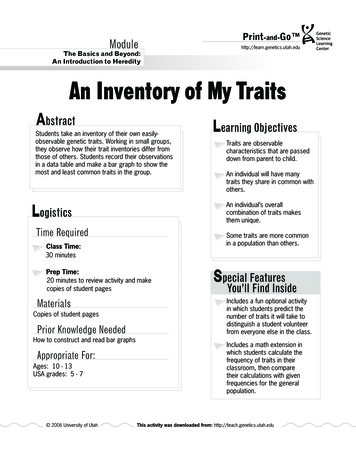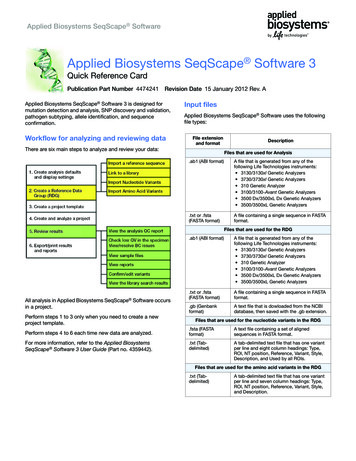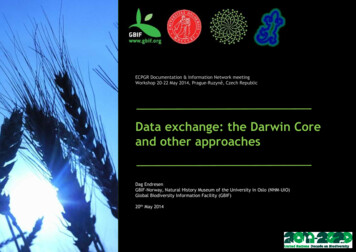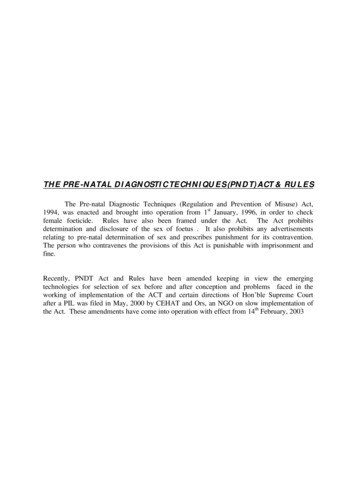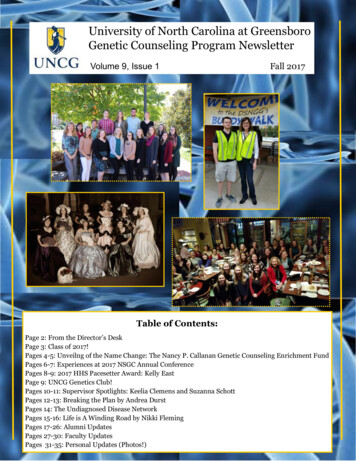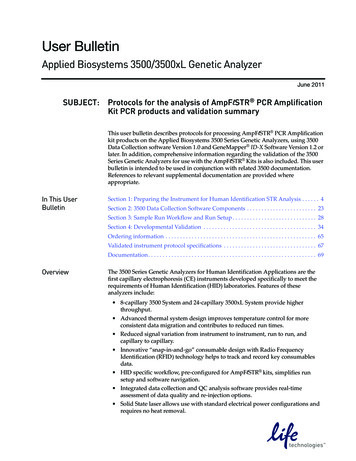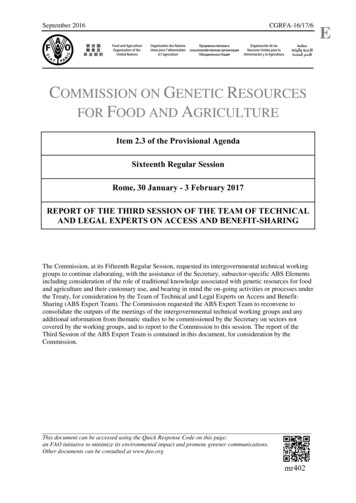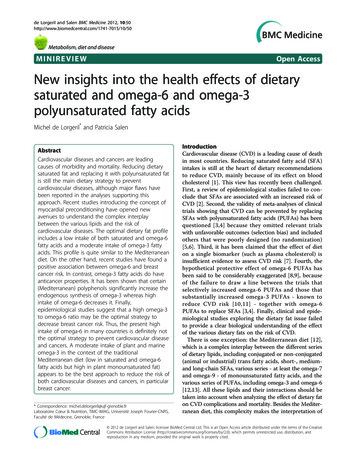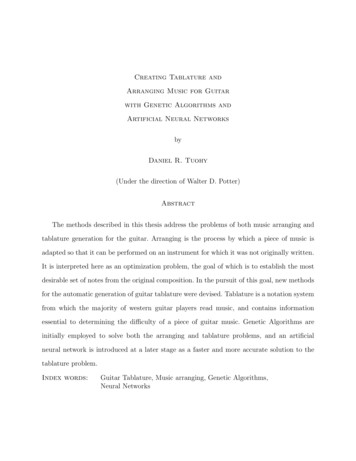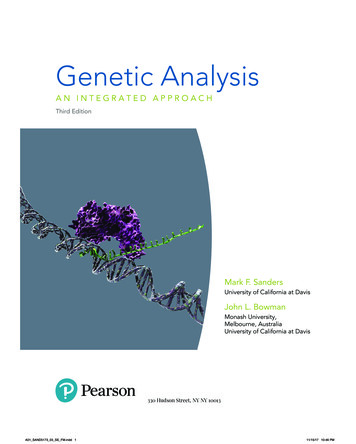
Transcription
Genetic AnalysisAN INTEGRATED APPROACHThird EditionMark F. SandersUniversity of California at DavisJohn L. BowmanMonash University,Melbourne, AustraliaUniversity of California at Davis330 Hudson Street, NY NY 10013A01 SAND5173 03 SE FM.indd 111/15/17 10:46 PM
Director, Courseware Portfolio Manager: Beth WilburCourseware Portfolio Manager: Michael GillespieContent Producer: Melanie FieldDevelopment Editor: Moira LernerCourseware Sr. Analysts, Content Development: Margot Otway,Barbara PriceCourseware Editorial Assistant: Summer GilesCourseware Director, Content Development: Ginnie Simione JutsonManaging Producer: Michael EarlyFull Service Project Manager: Thomas RussellFull Service Vendor: SPi GlobalDesign Manager: Mark OngInterior and Cover Design: CadenceRights and Permissions Project Manager: Linda DeMasiPhoto Researcher: Maureen SpuhlerRich Media Content Producer: Chloé VeylitManufacturing Buyer: Stacey WeinbergerProduct Marketing Manager: Christa PelaezField Marketing Manager: Kelly GalliCover Photo Credit: Gunilla Elam/Science Photo LibraryIllustrator: LachinaCopyright 2019, 2015 Pearson Education, Inc. All Rights Reserved. Printed in the United States of America.This publication is protected by copyright, and permission should be obtained from the publisher prior to anyprohibited reproduction, storage in a retrieval system, or transmission in any form or by any means, electronic,mechanical, photocopying, recording, or otherwise. For information regarding permissions, request forms andthe appropriate contacts within the Pearson Education Global Rights & Permissions department, please ts of third party content appear on page C-1, which constitutes an extension of this copyrightpage.PEARSON, ALWAYS LEARNING, and Mastering Genetics are exclusive trademarks in the U.S. and/or othercountries owned by Pearson Education, Inc. or its affiliates.Unless otherwise indicated herein, any third-party trademarks that may appear in this work are the property oftheir respective owners and any references to third-party trademarks, logos or other trade dress are for demonstrative or descriptive purposes only. Such references are not intended to imply any sponsorship, endorsement,authorization, or promotion of Pearson’s products by the owners of such marks, or any relationship between theowner and Pearson Education, Inc. or its affiliates, authors, licensees or distributors.Library of Congress Cataloging-in-Publication DataNames: Sanders, Mark Frederick, author. Bowman, John L., author.Title: Genetic analysis : an integrated approach / Mark F. Sanders, John L. Bowman.Description: Third edition. New York : Pearson Education, Inc., [2019] Includes bibliographical references and index.Identifiers: LCCN 2017052380 ISBN 9780134605173 ISBN 0134605179Subjects: MESH: Genetic Phenomena Genetic TechniquesClassification: LCC QH430 NLM QU 500 DDC 616/.042--dc23LC record available at https://lccn.loc.gov/20170523801 17ISBN-10: 0134605179ISBN-13: 9780134605173www.pearsonhighered.comA01 SAND5173 03 SE FM.indd 211/15/17 10:46 PM
Table of Contents1The Molecular Basis ofHeredity, Variation, andEvolution 11.12Transmission Genetics2.1The Development of Modern Genetics2Five Critical Experimental Innovations2.2The Four Phases of Modern Genetics 3Genetics—Central to Modern Biology 51.2Segregation of Alleles7DNA Replication 91.3102.3Hypothesis Testing by Test-Cross Analysis37Hypothesis Testing by F2 Self-Fertilization3839Dihybrid and Trihybrid Crosses Reveal theIndependent Assortment of Alleles 40DNA Transcription and MessengerRNA Translation Express Genes 11Dihybrid-Cross Analysis of Two GenesTranscription 12Testing Independent Assortment by Test-CrossAnalysis 43Experimental Insight 2.1Translation 13Genetic Analysis 1.21.43436Genetic Analysis 2.110Experimental Insight 1.1Monohybrid Crosses Reveal the Segregation of Alleles 34Evidence of Particulate Inheritance and Rejection of theBlending Theory 36The Discovery of DNA Structure 6Genetic Analysis 1.13133Identifying Dominant and Recessive TraitsThe Structure of DNA Suggestsa Mechanism for Replication 6DNA NucleotidesGregor Mendel Discovered the Basic Principles of Genetic Transmission 31Mendel’s Modern Experimental ApproachModern Genetics Is in Its SecondCentury 230Genetic Analysis 2.214404144Testing Independent Assortment by Trihybrid-CrossAnalysis 45Genetic Variation Can Be Detectedby Examining DNA, RNA, and Proteins 15The Rediscovery of Mendel’s WorkExperimental Insight 2.2Gel Electrophoresis 154646Stains, Blots, and Probes 162.4DNA Sequencing and Genomics 18Proteomics and Other “-omic” Analyses18Probability Theory Predicts MendelianRatios 47The Product Rule1.5The Sum RuleEvolution Has a Genetic Basis 19Binomial Probability 48Four Evolutionary Processes 20Genetic Analysis 1.324Case Study Ancient DNA: Genetics Looks intothe Past 24Summary 26 Preparing for ProblemSolving 27 Problems 2747Conditional Probability 47Darwin’s Theory of Evolution 19Tracing Evolutionary Relationships 21472.5Chi-Square Analysis Tests the Fitbetween Observed Values and ExpectedOutcomes 49Chi-Square Analysis50Chi-Square Analysis of Mendel’s Data50iiiA01 SAND5173 03 SE FM.indd 311/15/17 10:46 PM
iv CONTENTS2.6Autosomal Inheritance and MolecularGenetics Parallel the Predictions of Mendel’s Hereditary Principles 513.5Expression of X-Linked Recessive TraitsAutosomal Dominant Inheritance 52X-Linked Dominant Trait TransmissionAutosomal Recessive Inheritance 53Y-Linked InheritanceProspective and Retrospective Predictions inHuman Genetics 53Genetic Analysis 3.3Molecular Genetics of Mendel’s Traits 54Genetic Analysis 2.33.655Cell Division and Chromosome Heredity674.1Dosage Compensation Equalizes theExpression of Sex-Linked Genes 96Interactions between Alleles Produce Dominance Relationships 106Functional Effects of Mutation106107Notational Systems for Genes and AlleleRelationships 109Chromosome Movement and Distribution 72Incomplete DominanceCompletion of Cell Division 73CodominanceCell Cycle Checkpoints 74110110Dominance Relationships of ABO AllelesGenetic Analysis 4.1Meiosis Produces Cells for SexualReproduction 75Allelic Series113Meiosis Features Two Cell Divisions 75Lethal Alleles116Meiosis IDelayed Age of Onset76Meiosis II 79Meiosis Generates Mendelian Ratios 804.2113118Some Genes Produce VariablePhenotypes 118Sex-Influenced Traits 119Incomplete PenetranceVariable Expressivity84120120Gene–Environment InteractionsX-Linked Inheritance 85Pleiotropic GenesTesting the Chromosome Theory of Heredity 864.3Sex Determination Is Chromosomaland Genetic 87121122Gene Interaction Modifies MendelianRatios 122Gene Interaction in Pathways122Sex Determination in Drosophila 87The One Gene–One Enzyme HypothesisGenetic Analysis 3.2Experimental Insight 4.188Mammalian Sex Determination 89Genetic Analysis 4.2Experimental Insight 3.1Epistasis and Its ResultsA01 SAND5173 03 SE FM.indd 4124125Genetic Dissection to Investigate Gene ActionDiversity of Sex Determination 8990110Sex-Limited Traits 119The Chromosome Theory of HeredityProposes That Genes Are Carried onChromosomes 82Genetic Analysis 3.1105The Molecular Basis of DominanceMitosis Divides Somatic Cells 68Substages of M Phase 693.495Gene InteractionThe Cell Cycle 683.39393433.292Case Study The (Degenerative) Evolutionof the Mammalian Y Chromosome 97Summary 99 Preparing for ProblemSolving 99 Problems 100Case Study OMIM, Gene Mutations, and HumanHereditary Disease 57Summary 59 Preparing for ProblemSolving 60 Problems 603.1Human Sex-Linked Transmission FollowsDistinct Patterns 9112712812911/15/17 10:46 PM
CONTENTS v4.4Complementation Analysis DistinguishesMutations in the Same Gene from Mutations in Different Genes 133Allelic PhaseGenetic Analysis 4.3Genetic Analysis 5.3Lod Score AnalysisGenetic Analysis andMapping in Bacteria andBacteriophages 185Linked Genes Do Not AssortIndependently 1466.1Detecting Autosomal Genetic Linkage through Test-CrossAnalysis 150Characteristics of Bacterial GenomesGenetic Analysis 5.1Plasmids in Bacterial Cells1546.2The First Genetic Linkage Map 155Conjugation Identified 193Transfer of the F Factor 194Formation of an Hfr Chromosome 196Hfr Gene TransferThree-Point Test-Cross Analysis MapsGenes 156196Interrupted Mating and Time-of-Entry MappingTime-of-Entry Mapping Experiments198198Genetic Analysis 6.1199Constructing a Three-Point Recombination Map 158Consolidation of Hfr Maps200Determining Gamete Frequencies from Genetic Maps 161Conjugation with F′ Strains Produces Partial Diploids 201Correction of Genetic Map Distances 162Plasmids and Conjugation in ArchaeaGenetic Analysis 5.21636.3Multiple Factors Cause Recombinationto Vary 164Genetic Analysis 6.2204Steps in Transformation 205Recombination Is Dominated by Hotspots 165Mapping by Transformation 2056.4Bacterial Transduction Is Mediatedby Bacteriophages 205Human Genes Are Mapped Using Specialized Methods 166Bacteriophage Life CyclesMapping with Genetic MarkersCotransduction166The Inheritance of Disease-Causing Genes Linked toGenetic Markers 167A01 SAND5173 03 SE FM.indd 5203Bacterial Transformation Produces GeneticRecombination 203Sex Affects Recombination 164Genome Sequence Analysis Reveals RecombinationHotspot Distribution 1665.5189Bacteria Transfer Genes byConjugation 191Map Units156188189Research Technique 6.1Identifying Parental, Single-Crossover, and Double- Crossover Gametes in Three-Point Mapping 1575.4186Bacterial Culture and Growth AnalysisChi-Square Analysis of Genetic Linkage Data 1565.3Specialized Methods Are Used for GeneticAnalysis of Bacteria 186Cytological Evidence of Recombination 153Genetic Linkage Mapping Is Based on Recombination Frequency betweenGenes 1551746Detecting Genetic Linkage 1475.2172Case Study Mapping the Gene for CysticFibrosis 175Summary 176 Preparing for ProblemSolving 177 Problems 177145149172Linkage Disequilibrium and Evolutionary Analysis5The Discovery of Genetic Linkage171Genome-Wide Association StudiesCase Study Complementation Groups in a HumanCancer-Prone Disorder 136Summary 137 Preparing for ProblemSolving 138 Problems 1385.1169Experimental Insight 5.1134Genetic Linkage and Mapping in Eukaryotes168Generalized Transduction205208209Cotransduction Mapping209Specialized Transduction21111/15/17 10:46 PM
vi CONTENTS6.5Bacteriophage Chromosomes Are Mappedby Fine-Structure Analysis 211Genetic Analysis 6.37.3Three Competing Models of Replication212The Meselson–Stahl Experiment 245Intragenic Recombination Analysis 213Origin and Directionality of Replication inBacterial DNA 247Lateral Gene Transfer Alters Genomes 214Lateral Gene Transfer and Genome Evolution 215Multiple Replication Origins in Eukaryotes7.4Identifying Lateral Gene Transfer in Genomes 216APPLICATIONATypes of Hereditary Disease 225DNA Proofreading 256Supercoiling and Topoisomerases7.5262263New Generations of DNA Sequencing TechnologyGenetic Analysis 7.3Genetic Counseling and Ethical Issues 232266267Case Study DNA Helicase Gene Mutations andHuman Progeroid Syndrome 269Summary 270 Preparing for ProblemSolving 271 Problems 27123323478DNA Structure andReplication 235Molecular Biology ofTranscription and RNAProcessing 275DNA Is the Hereditary Molecule of Life 236Chromosomes Contain DNA236A Transformation Factor Responsible for Heredity 236DNA Is the Transformation Factor 2388.1DNA Is the Hereditary Molecule 238The DNA Double Helix Consists ofTwo Complementary and AntiparallelStrands 240DNA Nucleotides 240241Genetic Analysis 7.1A01 SAND5173 03 SE FM.indd 6261Dideoxynucleotide DNA SequencingEthical Issues in Genetic Medicine 231The DNA DuplexMethods of Molecular Genetic Analysis Make Use of DNA ReplicationProcesses 260Separation of PCR ProductsAssessing and Communicating Risks and Options 228257258The Polymerase Chain ReactionGenetic Counseling 227Indicators and Goals of Genetic Counseling 2277.2257Replication at the Ends of Linear ChromosomesGenetic Testing and Diagnosis 2267.1253RNA Primer Removal and Okazaki FragmentLigation 254Synthesis of Leading and Lagging Strands at the Replication Fork 255Hereditary Disease and Disease Genes 225Problems253Continuous and Discontinuous Strand ReplicationGenetic Analysis 7.2In Closing249Molecular Biology of Replication InitiationHuman Hereditary Diseaseand Genetic CounselingA.2248DNA Replication Precisely Duplicates theGenetic Material 249DNA Sequences at Replication OriginsCase Study The Evolution of Antibiotic Resistanceand Its Impact on Medical Practice 217Summary 218 Preparing for ProblemSolving 219 Problems 219A.1245Genetic Complementation Analysis 213Deletion-Mapping Analysis 2146.6DNA Replication Is Semiconservativeand Bidirectional 244RNA Transcripts Carry the Messages ofGenes 276RNA Nucleotides and StructureCategories of RNA8.2277278Bacterial Transcription Is a Four-StageProcess 279Bacterial RNA Polymerase244276Experimental Discovery of Messenger RNABacterial Promoters28028011/15/17 10:46 PM
CONTENTS viiTranscription Initiation 281Ribosome StructuresGenetic Analysis 8.1A Three-Dimensional View of the Ribosome283Research Technique 9.1Transcription Elongation and Termination 284Transcription Termination Mechanisms 2848.3Eukaryotic Transcription Is More Diversified and Complex than BacterialTranscription 2869.2Pol II Promoter Recognition 289Detecting Promoter Consensus Elements 290Translation Termination9.3Archaeal Promoters and Transcription292The Genetic Code Translates MessengerRNA into Polypeptide 329Genetic Analysis 9.2332Charging tRNA Molecules333The Signal HypothesisThe Torpedo Model of Transcription Termination 2969.5Splicing Signal Sequences 298334Experiments Deciphered the GeneticCode 334A Triplet Genetic Code336Alternative Patterns of RNA Transcription and AlternativeRNA Splicing 301No Gaps in the Genetic CodeSelf-Splicing Introns 302Genetic Analysis 9.3303307Case Study Sexy Splicing: Alternative mRNA Splicingand Sex Determination in Drosophila 307Summary 308 Preparing for ProblemSolving 309 Problems 309APPLICATION339BHuman Genetic ScreeningB.1The Molecular Biologyof Translation 314Polypeptides Are Amino Acid Chains ThatAre Assembled at Ribosomes 315337Case Study Antibiotics and TranslationInterference 340Summary 340 Preparing for ProblemSolving 341 Problems 342Transfer RNA Processing 3049336Deciphering the Genetic CodeRibosomal RNA Processing 304RNA Editing335No Overlap in the Genetic CodeA Gene Expression Machine Couples Transcription andPre-mRNA Processing 298Genetic Analysis 8.2Presymptomatic Diagnosis of Huntington’sDisease 348Trinucleotide Repeat ExpansionDetecting the Number of RepeatsB.2348348Newborn Genetic Screening 349Phenylketonuria and the First Newborn Genetic TestAmino Acid Structure 315Living with PKUPolypeptide and Transcript Structure 315The Recommended Uniform Screening PanelA01 SAND5173 03 SE FM.indd 7330331Protein Folding and Posttranslational PolypeptideProcessing 333Polyadenylation of 3′ Pre-mRNA 2959.1327The Genetic Code Displays Third-Base WobbleCapping 5′ Pre-mRNA 294Introns 296Translation Is Fast and Efficient 327The (Almost) Universal Genetic CodePosttranscriptional Processing ModifiesRNA Molecules 294Pre-mRNA Splicing 297327Translation of Polycistronic mRNA 329The Evolutionary Implications of ComparativeTranscription 2938.4326The Translational Complex9.4RNA Polymerase III Promoters 292324Genetic Analysis 9.1Other Regulatory Sequences and Chromatin-BasedRegulation of RNA Pol II Transcription 291RNA Polymerase I Promoters 292320Polypeptide Elongation288319319Translation Occurs in Three Phases 320Translation InitiationPolymerase II Transcription of mRNA in Eukaryotes 287Research Technique 8.131734935035111/15/17 10:46 PM
viii CONTENTSB.3Genetic Testing to Identify Carriers 353Testing Blood Proteins 353DNA-Based Carrier Screening and DiagnosticVerification 35310.4 Chromosome Breakage Causes Mutationby Loss, Gain, and Rearrangement ofChromosomes 375Partial Chromosome DeletionUnequal Crossover 376Pharmacogenetic Screening 354Detecting Duplication and DeletionDeletion MappingB.4375Carrier Screening Criteria 353377377Prenatal Genetic Testing 354Invasive Screening Using Amniocentesis or Chorionic Villus Sampling 354Noninvasive Prenatal Testing 356Maternal Serum Screening 356Preimplantation Genetic Screening 356B.5Direct-to-Consumer Genetic Testing 357B.6Opportunities and Choices 359Problems 3591010.5 Chromosome Breakage Leadsto Inversion and Translocationof Chromosomes 378Chromosome InversionGenetic Analysis 10.310.1 Chromosome Number and Shape Varyamong Organisms 362Chromosomes in Nuclei 362Chromosome Visualization 363379Experimental Insight 10.1Chromosome Translocation38238310.6 Eukaryotic Chromosomes Are Organizedinto Chromatin 385Chromatin CompactionEukaryotic C hromosomeAbnormalities and Molecular Organization 361378386Histone Proteins and Nucleosomes386Higher Order Chromatin Organization and ChromosomeStructure 389Nucleosome Disassembly, Synthesis, and Reassemblyduring Replication 389Position Effect Variegation: Effect of Chromatin State onTranscription 390Case Study Human Chromosome EvolutionSummary 393 Preparing for ProblemSolving 394 Problems 394392Chromosome Banding 364Heterochromatin and Euchromatin 36510.2 Nondisjunction Leads to Changes in Chromosome Number 366Chromosome Nondisjunction 366Gene Dosage Alteration 366Genetic Analysis 10.111Gene Mutation, DNARepair, and HomologousRecombination 39936811.1 Mutations Are Rare and Random and AlterDNA Sequence 400Aneuploidy in Humans 368Mosaicism 370Proof of the Random Mutation HypothesisUniparental Disomy 371400Germ-Line and Somatic Mutations 40110.3 Changes in Euploid Content Leadto Polyploidy 371Point Mutations401Base-Pair Substitution MutationsCauses of Autopolyploidy and Allopolyploidy 371Frameshift Mutations402Genetic Analysis 10.2Regulatory Mutations402372Consequences of Polyploidy 373Polyploidy and EvolutionA01 SAND5173 03 SE FM.indd 8374401Experimental Insight 11.1404Forward Mutation and Reversion40511/15/17 10:46 PM
CONTENTS ix1211.2 Gene Mutations May Arise from Spontaneous Events 405Regulation of GeneExpression in Bacteria andBacteriophage 439Spontaneous DNA Replication Errors 405Genetic Analysis 11.1407Spontaneous Nucleotide Base Changes 40911.3 Mutations May Be Caused by Chemicalsor Ionizing Radiation 410Chemical Mutagens 41012.1 Transcriptional Control of Gene Expression Requires DNA–ProteinInteraction 440Radiation-Induced DNA Damage 412Negative and Positive Control of TranscriptionThe Ames TestRegulatory DNA-Binding Proteins41312.2 The lac Operon Is an Inducible OperonSystem under Negative and PositiveControl 44311.4 Repair Systems Correct Some DNADamage 415Direct Repair of DNA Damage 415Genetic Analysis 11.2Lactose Metabolism416DNA Damage-Signaling Systems 41911.5 Proteins Control Translesion DNA Synthesis and the Repair of Double-StrandBreaks 420443lac Operon Structure444lac Operon Function44412.3 Mutational Analysis Deciphers Genetic Regulation of the lac Operon 447Translesion DNA Synthesis 420Double-Strand Break Repair 420Molecular Analysis of the lac OperonGenetic Analysis 12.111.6 DNA Double-Strand Breaks Initiate Homologous Recombination 422The Holliday Model 422The Bacterial RecBCD Pathway 422The Double-Stranded Break Model of HomologousRecombination 42244845312.4 Transcription from the Tryptophan OperonIs Repressible and Attenuated 454Feedback Inhibition of Tryptophan SynthesisAttenuation of the trp OperonThe Characteristics and Classification of TransposableElements 425The Mutagenic Effect of Transposition 426Transposable Elements in Bacterial Genomes 426459Alternative Sigma Factors and Stress ResponseThe Discovery of Ds and Ac Elements in MaizeTranslational Regulation in BacteriaCase Study Mendel’s Peas Are Shaped byTransposition 431Summary 432 Preparing for ProblemSolving 434 Problems 434A01 SAND5173 03 SE FM.indd 9459460Genetic Analysis 12.242745912.5 Bacteria Regulate the Transcriptionof Stress Response Genes and AlsoTranslation 459Transposable Elements in Eukaryotic Genomes 427Retrotransposons 430455456Attenuation in Other Amino Acid Operon Systems11.7 Transposable Genetic Elements Movethroughout the Genome 425Drosophila P Elements 429451452Experimental Insight 12.1Attenuation Mutations428447Analysis of Structural Gene Mutationslac Operon Regulatory MutationsGenetic Analysis 11.344144146112.6 Riboswitches Regulate Bacterial Transcription, Translation, and mRNAStability 462Riboswitch Regulation of TranscriptionRiboswitch Regulation of TranslationRiboswitch Control of mRNA Stability46246346411/15/17 10:46 PM
x CONTENTS12.7 Antiterminators and Repressors ControlLambda Phage Infection of E. coli 464The Lambda Phage Genome 46513.3 RNA-Mediated Mechanisms Control GeneExpression 498Gene Silencing by Double-Stranded RNA499Early Gene Transcription 465Constitutive Heterochromatin MaintenanceCro Protein and the Lytic Cycle 466The Evolution and Applications of RNAiThe l Repressor Protein and Lysogeny 468Case Study Environmental Epigenetics 502Summary 503 Preparing for ProblemSolving 504 Problems 504Resumption of the Lytic Cycle following LysogenyInduction 468Case Study Vibrio cholerae—Stress Response Leadsto Serious Infection Through Positive Control ofTranscription 469Summary 470 Preparing for ProblemSolving 471 Problems 47113Regulation ofGene Expression inEukaryotes 47613.1 Cis-Acting Regulatory Sequences BindTrans-Acting Regulatory Proteins to ControlEukaryotic Transcription 478Overview of Transcriptional Regulatory Interactions inEukaryotes 479Integration and Modularity of Eukaryotic RegulatorySequences 480Locus Control Regions 48114Analysis of Gene Functionby Forward Genetics andReverse Genetics 50714.1 Forward Genetic Screens Identify Genesby Their Mutant Phenotypes 509General Design of Forward Genetic ScreensAnalysis of Mutageneses513Genetic Analysis 14.151514.2 Genes Identified by Mutant PhenotypeAre Cloned Using Recombinant DNATechnology 516Yeast as a Simple Model for EukaryoticTranscription 482Genome Sequencing to Determine GeneIdentification 51751614.3 Reverse Genetics Investigates Gene Actionby Progressing from Gene Identification toPhenotype 519PEV Mutations 485Genome EditingOverview of Chromatin Remodeling and ChromatinModification 486Use of Insertion Mutants in Reverse Genetics519Use of Homologous Recombination in Reverse Genetics 522Open and Covered Promoters 486RNA Interference in Gene ActivityMechanisms of Chromatin Remodeling 487Reverse Genetics by TILLINGChemical Modifications of Chromatin 488Genetic Analysis 14.2Genetic Analysis 13.1509Identifying Interacting and Redundant Genes UsingModifier Screens 514Cloning Genes by Complementation13.2 Chromatin Remodeling and ModificationRegulates Eukaryotic Transcription 484509Specific Strategies of Forward Genetic ScreensEnhancer-Sequence Conservation 482Insulator Sequences 484501502524525525527490An Example of Inducible Transcriptional Regulation inS. cerevisiae 49314.4 Transgenes Provide a Means of DissectingGene Function 527Monitoring Gene Expression with Reporter GenesFacultative Heterochromatin and DevelopmentalGenes 494Enhancer Trapping 531Epigenetic Heritability 494Investigating Gene Function with Chimeric GeneslncRNAs and Inactivation of Eutherian MammalianFemale X Chromosomes 496Genomic Imprinting 497Nucleotide Methylation 498A01 SAND5173 03 SE FM.indd 10528532Case Study Reverse Genetics and Genetic Redundancyin Flower Development 533Summary 535 Preparing for ProblemSolving 535 Problems 53511/15/17 10:46 PM
CONTENTS xiAPPLICATIONC15.3 Gene Therapy Uses Recombinant DNATechnology 579The Geneticsof CancerTwo Forms of Gene TherapySomatic Gene Therapy Using ES CellsGenetic Analysis 15.2C.1Cancer Is a Somatic Genetic Disease that IsOnly Occasionally Inherited 540C.2What Is Cancer and What Are the Characteristics of Cancer? 540Progression of Abnormalities 540The Hallmarks of Cancer Cells and Malignant Tumors 541C.3The Genetic Basis of Cancer 543Single Gene Mutations and Cancer Development543The Genetic Progression of Cancer Development and Cancer Predisposition 546Breast and Ovarian Cancer and the Inheritance of CancerSusceptibility 548C.4Cancer Cell Genome Sequencing andImprovements in Therapy 549The Cancer Genome Atlas57958015.4 Cloning of Plants and Animals ProducesGenetically Identical Individuals 583Case Study Gene Drive Alleles Can Rapidly SpreadThrough Populations 585Summary 587 Preparing for ProblemSolving 588 Problems 58816Genomics: Geneticsfrom a Whole-GenomePerspective 59316.1 Structural Genomics Provides a Catalog ofGenes in a Genome 594549Epigenetic Irregularities 549Whole-Genome Shotgun SequencingTargeted Cancer Therapy 550Reference Genomes and ResequencingProblems 550Metagenomics 600Experimental Insight 16.115601Restriction Enzymes 553Research Technique 16.1603604Related Genes and Protein Motifs605Variation in Genome Organization among SpeciesThree Insights from Genome Sequences60560655416.3 Evolutionary Genomics Traces the History ofGenomes 607556Molecular Cloning 557The Tree of Life 608DNA Libraries 562Advances in Altering and Synthesizing DNA Molecules 56415.2 Introducing Foreign Genes into GenomesCreates Transgenic Organisms 565Expression of Heterologous Genes in Bacterial and FungalHosts 565Experimental Insight 15.2602Computational Approaches to StructuralAnnotation 60215.1 Specific DNA Sequences Are Identifiedand Manipulated Using Recombinant DNATechnology 553Experimental Insight 15.1599Experimental Approaches to Structural AnnotationFunctional Gene Annotation569Transformation of Plant Genomes by AgrobacteriumTransgenic Animals 574Manipulation of DNA Sequences in Vivo 578A01 SAND5173 03 SE FM.indd 1159616.2 Annotation Ascribes Biological Function toDNA Sequences 602Recombinant DNA Technology and ItsApplications 552Genetic Analysis 15.1579570Interspecific Genome Comparisons: Gene ContentResearch Technique 16.2Genetic Analysis 16.1608610614Interspecific Genome Comparisons: GenomeAnnotation 615Interspecific Genome Comparisons: Gene Order61616.4 Functional Genomics Aims to ElucidateGene Function 618Transcriptomics61911/15/17 10:46 PM
xii CONTENTSOther “-omes” and “-omics” 621Continual DNA Transfer from Organelles654Use of Yeast Mutants to Categorize Genes 624Encoding of Organellar ProteinsGenetic Networks 625The Origin of the Eukaryotic LineageCase Study Genomic Analysis of Insect GutsMay Fuel the World 627Summary 628 Preparing for ProblemSolving 628 Problems 629Secondary and Tertiary Endosymbioses 65617Organellar Inheritance andthe Evolution of OrganellarGenomes 63217.1 Organellar Inheritance Transmits Genes Carried on Organellar Chromosomes 633The Discovery of Organellar Inheritance 633Homoplasmy and Heteroplasmy 634655656Case Study Ototoxic Deafness: A MitochondrialGene–Environment Interaction 658Summary 659 Preparing for ProblemSolving 660 Problems 66018DevelopmentalGenetics 66318.1 Development Is the Building of a Multicellular Organism 664Cell Differentiation665Pattern Formation 665Genome Replication in Organelles 635Replicative Segregation of Organelle Genomes 63517.2 Modes of Organellar Inheritance Dependon the Organism 636Mitochondrial Inheritance in Mammals 637Genetic Analysis 17.163918.2 Drosophila Development Is a Paradigmfor Animal Development 666The Developmental Toolkit of DrosophilaMaternal Effects on Pattern Formation667669Coordinate Gene Patterning of the Anterior–PosteriorAxis 669Mating Type and Chloroplast Segregation inChlamydomonas 640Domains of Gap Gene ExpressionBiparental Inheritance in Saccharomyces cerevisiae 641Specification of Parasegments by Hox GenesGenetic Analysis 17.2Regulation of Pair-Rule Genes670671Downstream Targets of Hox Genes643Summary of Organellar Inheritance 64417.3 Mitochondria Are the Energy Factories ofEukaryotic Cells 644675Hox Genes throughout MetazoansGenetic Analysis 18.1673676677Stabilization of Cellular Memory by ChromatinArchitecture 678Mitochondrial Genome Structure and Gene Content 645Mitochondrial Transcription and Translation 64617.4 Chloroplasts Are the Sites ofPhotosynthesis 64818.3 Cellular Interactions Specify Cell Fate 679Inductive Signaling between Cells679Lateral Inhibition 682Cell Death During Development682Chloroplast Genome Structure and Gene Content 648Chloroplast Transcription and Translation 649Editing of Chloroplast mRNA65017.5 The Endosymbiosis Theory Explains Mitochondrial and ChloroplastEvolution 651Separate Evolution of Mitochondria andChloroplasts 651Experimental Insight 17.1A01 SAND5173 03 SE FM.indd 1265218.4 “Evolution Behaves Like a Tinkerer” 683Evolution through Co-option 683Constraints on Co-option68518.5 Plants Represent an Independent Experiment in Multicellular Evolution 685Development at Meristems685Combinatorial Homeotic Activity in Floral-OrganIdentity 68611/15/17 10:46 PM
CONTENTS xiiiGenetic Analysis 18.220689Case Study Cyclopia and Polydactyly—D ifferent Shh Mutations with DistinctivePhenotypes 690Summary 691 Preparing for ProblemSolving 692 Problems 692Population Genetics andEvolution at the Population,Species, and MolecularLevels 7251920.1 The Hardy–Weinberg Equilibrium Describesthe Relationship of Allele and GenotypeFrequencies in Populations 726Genetic Analysis of Quantitative Traits 696Populations and Gene Pools19.1 Quantitative Traits Display Continuous Phenotype Variation 697Genetic Potential697727The Hardy–Weinberg Equilibrium 727Determining Autosomal Allele Frequencies inPopulations 729The Hardy–Weinberg Equilibrium for More than TwoAlleles 731Major Gene Effects 698Additive Gene Effects 698Continuous Phenotypic Variation from Multiple AdditiveGenes 699Allele Segregation in Quantitative TraitProduction 701Genetic Analysis 20.173220.2 Natural Selection Operates through Differential Reproductive Fitness withina Population 732Effects of Environmental Factors on PhenotypicVariation 702Genetic Analysis 19.1The Chi-Square Test of Hardy–WeinbergPredictions 731703Differential Reproductive
vi CONTENTS 7.3 DNA Replication Is Semiconservative and Bidirectional 244 Three Competing Models of Replication 245 The Meselson-Stahl Experiment 245 Origin and Directionality of Replication in

